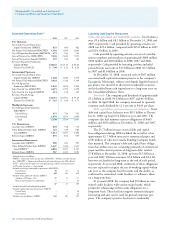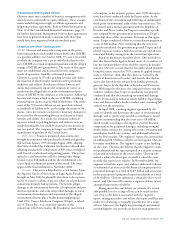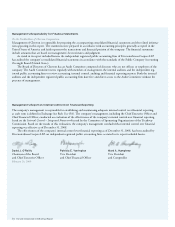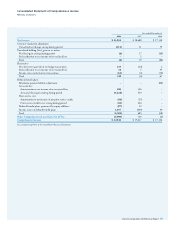Chevron 2008 Annual Report Download - page 52
Download and view the complete annual report
Please find page 52 of the 2008 Chevron annual report below. You can navigate through the pages in the report by either clicking on the pages listed below, or by using the keyword search tool below to find specific information within the annual report.
Management’s Discussion and Analysis of
Financial Condition and Results of Operations
50 Chevron Corporation 2008 Annual Report
sidered acceptable at the time but now require investigative or
remedial work or both to meet current standards.
Using definitions and guidelines established by the Amer-
ican Petroleum Institute, Chevron estimated its worldwide
environmental spending in 2008 at approximately $3.1 billion
for its consolidated companies. Included in these expenditures
were approximately $1.3 billion of environmental capital
expenditures and $1.8 billion of costs associated with the
prevention, control, abatement or elimination of hazardous
substances and pollutants from operating, closed or divested
sites, and the abandonment and restoration of sites.
For 2009, total worldwide environmental capital expen-
ditures are estimated at $2.2 billion. These capital costs are
in addition to the ongoing costs of complying with envi-
ronmental regulations and the costs to remediate previously
contaminated sites.
It is not possible to predict with certainty the amount
of additional investments in new or existing facilities or
amounts of incremental operating costs to be incurred in the
future to: prevent, control, reduce or eliminate releases of
hazardous materials into the environment; comply with exist-
ing and new environmental laws or regulations; or remediate
and restore areas damaged by prior releases of hazardous
materials. Although these costs may be significant to the
results of operations in any single period, the company does
not expect them to have a material effect on the company’s
liquidity or financial position.
Critical Accounting Estimates and Assumptions
Management makes many estimates and assumptions in
the application of generally accepted accounting principles
(GAAP) that may have a material impact on the company’s
consolidated financial statements and related disclosures
and on the comparability of such information over different
reporting periods. All such estimates and assumptions affect
reported amounts of assets, liabilities, revenues and expenses,
as well as disclosures of contingent assets and liabilities.
Estimates and assumptions are based on management’s expe-
rience and other information available prior to the issuance
of the financial statements. Materially different results can
occur as circumstances change and additional information
becomes known.
The discussion in this section of “critical” accounting esti-
mates or assumptions is according to the disclosure guidelines
of the Securities and Exchange Commission (SEC), wherein:
1. the nature of the estimates or assumptions is material
due to the levels of subjectivity and judgment neces-
sary to account for highly uncertain matters or the
susceptibility of such matters to change; and
2. the impact of the estimates and assumptions on the
company’s financial condition or operating perfor-
mance is material.
Besides those meeting these “critical” criteria, the
company makes many other accounting estimates and
assumptions in preparing its financial statements and related
disclosures. Although not associated with “highly uncertain
matters,” these estimates and assumptions are also subject to
revision as circumstances warrant, and materially different
results may sometimes occur.
For example, the recording of deferred tax assets
requires an assessment under the accounting rules that the
future realization of the associated tax benefits be “more
likely than not.” Another example is the estimation of
crude oil and natural gas reserves under SEC rules that
require “… geological and engineering data (that) demon-
strate with reasonable certainty (reserves) to be recoverable
in future years from known reservoirs under existing eco-
nomic and operating conditions, i.e., prices and costs as of
the date the estimate is made.” Refer to Table V, “Reserve
Quantity Information,” beginning on page 98, for the
changes in these estimates for the three years ending
December 31, 2008, and to Table VII, “Changes in the
Standardized Measure of Discounted Future Net Cash
Flows From Proved Reserves” on page 105 for estimates
of proved-reserve values for each of the three years ended
December 31, 2008, which were based on year-end prices
at the time. Note 1 to the Consolidated Financial State-
ments, beginning on page 63, includes a description of
the “successful efforts” method of accounting for oil and
gas exploration and production activities. The estimates
of crude oil and natural gas reserves are important to the
timing of expense recognition for costs incurred.
The discussion of the critical accounting policy for
“Impairment of Properties, Plant and Equipment and
Investments in Affiliates,” beginning on page 52,
includes reference to conditions under which downward
revisions of proved-reserve quantities could result in
impairments of oil and gas properties. This commentary
should be read in conjunction with disclosures elsewhere
in this discussion and in the Notes to the Consolidated
Financial Statements related to estimates, uncertainties,
contingencies and new accounting standards. Significant
accounting policies are discussed in Note 1 to the Con-
solidated Financial Statements, beginning on page 63.
The development and selection of accounting estimates
























